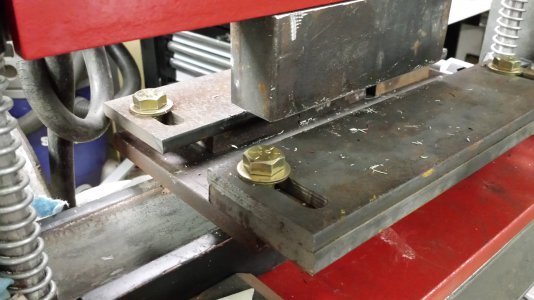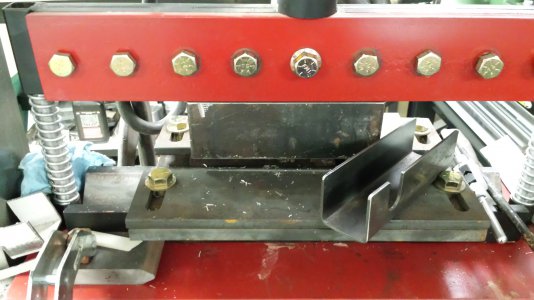- Joined
- Apr 1, 2013
- Messages
- 1,142
So here is what I am working with, A HF hydraulic shop press, a home made brake attachment, and a squared top die 1-1/2" x 6" long. Also a adjustable bottom die I made.

Here is what I am trying to do form a piece of 11g. into a u shape 1-1/2" inside.( Actually I did get it but not without some hand bending.)

The issue is when I press the part though It bends but it springs back enough to cause the part to be flared. I set the clearance between the top and bottom dies with a scrap of 11g on each side to a slide fit. I have seen dies set up to fold a box shape before with the sides coming out at 90deg. do I need to mill a relief in the sides of the top die? or what am I missing?
As you guys can tell I am no die maker. Hoping someone with some die make experience can set me straight. I managed to make this one work but I would like to be able to make these kinds of bends whenever the need arises. The first photo shows my crude set up the second shows the part I was making. Any help would be appreciated.
Mark

Here is what I am trying to do form a piece of 11g. into a u shape 1-1/2" inside.( Actually I did get it but not without some hand bending.)

The issue is when I press the part though It bends but it springs back enough to cause the part to be flared. I set the clearance between the top and bottom dies with a scrap of 11g on each side to a slide fit. I have seen dies set up to fold a box shape before with the sides coming out at 90deg. do I need to mill a relief in the sides of the top die? or what am I missing?
As you guys can tell I am no die maker. Hoping someone with some die make experience can set me straight. I managed to make this one work but I would like to be able to make these kinds of bends whenever the need arises. The first photo shows my crude set up the second shows the part I was making. Any help would be appreciated.
Mark

